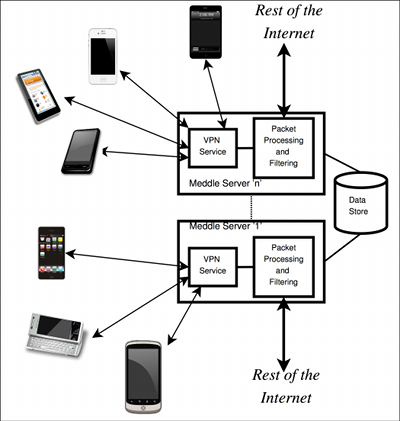How does Meddle work?
Meddle, a framework that combines virtual private networks (VPNs) with middleboxes to provide an experimental platform that aligns the interests of users and researchers. Meddle relies on VPN tunnels to access the mobile traffic regardless of the device, OS, wireless technology, and carrier. Meddle can thus provide a continuous and comprehensive view of how mobile devices interact with the Internet. Once packets arrive at a Meddle server, we use a variety of middlebox approaches to interpose on mobile-device traffic.
Meddle offers new opportunities for measuring and characterizing mobile traffic, and designing new in-network features to improve the mobile experience. For example, by accessing network traffic regardless of the wireless technology we can analyze how different operating systems and apps offload their traffic from cellular networks to Wi-Fi. To improve the user experience, we implement packet filters to block ads; unlike existing packet filters for mobile devices, the packet filters provided by Meddle do not require jail-breaking the mobile device. Furthermore, Meddle provides a vantage point for separating mobile-network performance from server-side performance, thus improving bottleneck identification for mobile applications. Meddle also enables researchers to investigate what-if scenarios for the impact of new middleboxes as if they were deployed in carrier networks. For example, Meddle can be used to deploy anonymization systems such as Privad.
Meddle uses VPNs as a portable mechanism to tunnel the data traffic from mobile devices to a machine where users and researchers can exert control over network flows. VPNs also reduce the barrier to entry for deploying Meddle because Android, BlackBerry, and iOS, which represent more than 86% of the mobile device market, have native VPN support. As shown in the above figure, when a mobile device connects to the Internet, we tunnel its traffic via a nearby Meddle server in a similar way to how CDNs use DNS to redirect Web clients to nearby content caches. On each Meddle server we implement custom services for users such as packet filtering, caching, and intrusion detection. Meddle thus takes two well-known technologies -- VPNs and middleboxes -- and combines them in unintended ways for the mobile environment.Technical details
We are in the early stages of Meddle development, so we provide only a few white paper summaries at the moment. We will update the list below as Meddle matures.
- Arash Molavi Kakhki, Abbas Razaghpanah, Rajesh Golani, David Choffnes, Phillipa Gill, Alan Mislove Identifying Traffic Differentiation on Cellular Data Networks. In SIGCOMM Student Research Competition (2nd place). August, 2014 (Abstract) (Poster) (Presentation)
- David Choffnes, Improving Transparency and Control in Mobile Systems, Presentation given at MSR Redmond, Dagstuhl, AIMS, IIT Bombay, Brown University, MSR Asia, PKU and Tsinghua. (Download PDF)
- Ashwin Rao, Arash Molavi Kakhki, Abbas Razaghpanah, Amy Tang, Shen Wang, Justine Sherry, Phillipa Gill, Arvind Krishnamurthy, Arnaud Legout, Alan Mislove, and David Choffnes.
Using the Middle to Meddle with Mobile Tech. Report NEU-CCS-2013-12-10, CCIS, Northeastern University, December 2013. (Download PDF) - Meddle: Middleboxes for Increased Transparency and Control of Mobile Traffic. In the CoNEXT 2012 Student Workshop. Awarded Best Paper (along with 7 others) Download PDF
